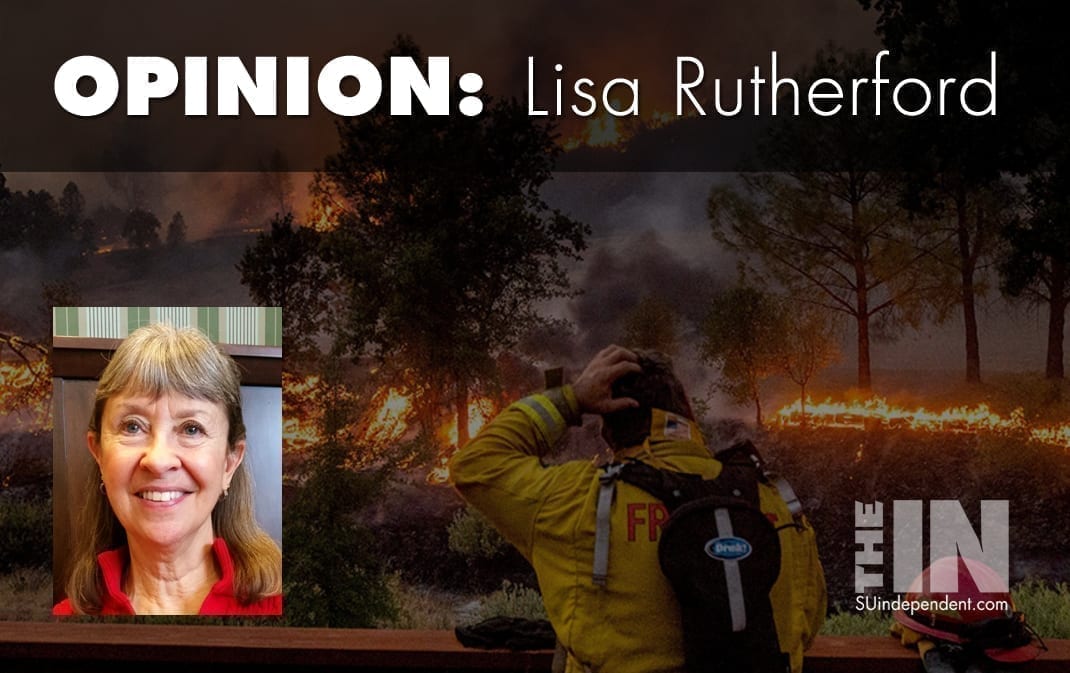
Wildfires and Climate Change – Where To Go?
By Lisa Rutherford
As I witness the devastating and horrific fires along the West Coast, my heart goes out to those who are experiencing these events. One story about a man in Oregon who was able to save his wife while his thirteen-year-old son and ninety-two-year-old mother-in-law perished in the fire brought me to tears, as I’m sure it should anyone. And there are many more heart-wrenching stories.
How have we come to this point? How can people deal with this now and in the future? And it will be our future if big changes are not forthcoming. Climate change has created a situation that will continue to challenge us even if we make needed changes (which we must!) and about which I feel particularly concerned given my twenty-year career in the oil/gas industry. My work contributed to the situation in which we now find ourselves. Now, that said, our product was needed, in fact, demanded, by the American public and industry and still is. But we have been warned since the 80s about the increasing carbon dioxide levels and the effects of that due to our reliance on fossil fuels. We have ignored those warnings and now are seeing that the predictions were accurate. Adding to the problem has been cheap coal, but we are paying the piper now—not just a price from our pockets but a price calculated in lives! There are no free lunches, folks.
There’s blame to go around for the increased carbon dioxide levels in this nation and world. Many have insisted on driving gas-guzzling trucks whether needed or not. If not gas-guzzling trucks, then gas-guzzling vehicles of some other type have been the choice. Not all can afford (or desire, due to politics) to own a hybrid or total-electric cars, which I will concede run on coal-based energy but do cause far fewer emissions on our millions of miles of highways. Air conditioners are run full bore resulting in the wearing of sweaters indoors while heaters are cranked up during the winter resulting in the doffing of clothing. Go figure.
I can visualize the climate change naysayers looking askance and shaking their heads. Yes, forest management or lack of management has added to the fuel load issue, which is making these mega-fires so deadly. But that fuel, too, is a result of climate change. Underbrush can accumulate with dry leaves and needles fallen from tinder-dry trees building fuel for fires. If not cleared, that’s a problem. Dry trees burn faster and hotter, too.
Then there’s the problem with people wanting to live in the forest with little thought (if any!) about the challenges that presents. According to researchers at the University of Colorado Boulder, between 1992 and 2015 32 million new homes have been built in the “wildland-urban interface” or WUI. More people living in the forest results in more people starting fires; 97 percent of the fires that destroy homes are human-caused. And the building boom will continue with developers eyeing the land available on which they can continue to build if governments continue approving their plans with dollar signs in their eyes, too. Many who live in these WUI areas refuse to provide a “defensible” area around their homes, but perhaps with these mega-fires, those would be for naught, also.
The result of all these behaviors is what we are now witnessing and the impacts are being felt. In Oregon for example, fire fighting forces are stretched to their limits. Citizens in Oregon are resorting to fighting the fires themselves. Some complain about the government not getting there quickly enough, but these people, like most Americans, have been contributing to the problem with which they now must deal. It’s a challenging situation.
The strain is more than many can bear. School closures, financial strain, isolation all due to COVID, and social upheaval including Black Lives Matter demonstrations many with violent riots have strained people and now fires on top of those stresses. Everything is being called “unprecedented” but that term is getting worn thin.
Over the past 30-to-50-year period, burned acreage and numbers of fires correlate with a 2.5-degree Fahrenheit increase in the temperature, the effects of climate change.
What will people who are now living in—or rather, running from—these tinder-dry areas do? Continue living with the fear? Move? Where? In fact, what will we all do? Our past actions have placed us in a very precarious position. Will we continue down that road as we have for these forty years since the first climate change warnings were made? Will we continue to face more extreme weather as a result? Really, the choice is ours, but given the popularity of extreme-weather shows and people’s unwillingness to change, it’s looking bleak.
Viewpoints and perspectives expressed throughout The Independent are those of the individual contributors. They do not necessarily reflect those held by the staff of The Independent or our advertising sponsors. Your comments, rebuttals, and contributions are welcome in accordance with our Terms of Service. Please be respectful and abide by our Community Rules. If you have privacy concerns you can view our Privacy Policy here. Thank you!
Click here to submit an article, guest opinion piece, or a Letter to the Editor




